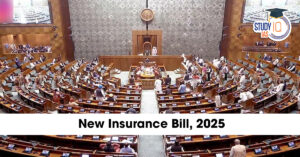Table of Contents
As India aspires to become a $30 trillion economy by 2047 under the Viksit Bharat vision, its cities must evolve from reactive growth centers into proactive engines of economic, environmental, and social transformation. The country’s current urban planning framework—characterized by outdated master plans and fragmented governance—requires urgent rethinking to handle rising population, climate pressures, and economic demands.
Need for Urban Planning and Strategic Role of Cities
1. Economic Drivers
Cities are the backbone of India’s economic growth, contributing over 63% of GDP and projected to reach 75% by 2030. Effective urban planning ensures this growth remains spatially efficient, economically inclusive, and sustainable.
2. Demographic Challenge
With over 400 million urban residents today, India’s urban population is expected to reach 600 million by 2036 and 800 million by 2050. Managing this surge requires systematic planning for housing, transport, sanitation, and energy infrastructure.
3. Climate Action Leadership
Cities are at the frontline of climate change — consuming massive energy and contributing substantially to greenhouse gas emissions. Achieving India’s net zero target by 2070 demands urban-led climate strategies focusing on renewable energy, sustainable transport, and green infrastructure.
Did You Know?
Urban planning is a function of Urban Local Bodies (ULBs) under the 12th Schedule of the Indian Constitution. The Ministry of Housing and Urban Affairs (MoHUA) supports ULBs through schemes like AMRUT, Smart Cities Mission, and Urban Learning Programs.
Limits of Traditional Urban Planning
Traditional Indian urban planning has largely depended on static master plans emphasizing rigid land zoning — residential, commercial, or industrial. This model has failed to keep pace with the dynamic realities of modern urbanization.
1. Fragmented Governance
Cities face overlapping jurisdictions, limited autonomy, and weak coordination among municipal bodies, leading to inefficient service delivery and slow urban development.
2. Mobility and Transport Gaps
Lack of integrated transport planning has increased congestion, pollution, and commute times. Public transport systems often fail to connect new growth corridors.
3. Environmental Stress
Rapid expansion has led to water scarcity, heat stress, and waste mismanagement. Few cities incorporate environmental impact assessments into their planning processes.
4. Social Inequality
Affordable housing, healthcare, and education are often afterthoughts, leaving millions in informal settlements without basic amenities.
5. Economic Stagnation
Land-use plans seldom account for innovation clusters, business hubs, or economic corridors. This limits employment generation and regional competitiveness.
6. Financial Constraints
According to a World Bank report, India will need nearly ₹70 lakh crore by 2036 to meet its urban infrastructure needs, while most cities lack the capacity to access or manage such financing.
Towards a New Paradigm of Urban Planning
1. Economic Vision as the Core
Every city needs a long-term economic vision (20–50 years) identifying growth sectors, employment potential, and land-use requirements. Urban plans must be economy-driven, not just land-driven.
2. Natural Resource Budgeting
Cities must evaluate their carrying capacity and integrate resource budgeting for water, waste, and energy. Promoting circular economy principles will ensure sustainability without overexploitation.
3. Climate Action Integration
Urban planning must embed Climate Action Plans (CAPs) aligned with India’s national emission reduction targets. This includes renewable energy adoption, electric mobility, and resilience infrastructure for floods and heatwaves.
4. Mobility and Environmental Planning
Cities must create Comprehensive Mobility Plans (CMPs) focusing on public transport, cycling, and pedestrian-friendly design to reduce emissions and improve accessibility.
5. Regional and Smaller City Integration
Urban development must adopt a regional approach, connecting cities with peri-urban and rural economies. Smaller Tier 2 and Tier 3 cities can become manufacturing and logistics hubs, easing pressure on metros.
6. Data-Driven Decision Making
Use of GIS mapping, real-time analytics, and digital dashboards can make planning adaptive and transparent. Smart city technologies can help forecast growth and manage resources efficiently.
Institutional and Educational Reforms
-
Revised Planning Laws:
Updating outdated Town & Country Planning Acts to incorporate economic, environmental, and regional objectives. -
Capacity Building:
Reforming planning and architecture curricula to train professionals for emerging challenges. -
Interdisciplinary Collaboration:
Encouraging cooperation between urban planners, economists, and environmental scientists to promote holistic design.
Government-Led Planning Reforms
-
NITI Aayog Report (2021): Proposed an All India Urban and Regional Planning Service and reforms in urban education and governance.
-
MoHUA’s URDPFI Guidelines & Model Bye-Laws: Promote efficient land-use, sustainability, and affordability.
-
India Infrastructure Report 2023: Stresses urban redevelopment and capacity building.
-
PM Gati Shakti National Master Plan: Integrates logistics, infrastructure, and urban planning for multimodal growth.
-
Smart Cities Mission: Enhances quality of life through data-driven governance and sustainable design.
-
Urban Infrastructure Investment: India currently spends 3.3% of GDP on infrastructure, prioritizing urban transport, housing, and connectivity.
Conclusion
India’s journey towards becoming a Viksit Bharat by 2047 depends on transforming its cities into smart, sustainable, and inclusive growth engines. Rethinking urban planning requires a paradigm shift — from rigid land-use zoning to integrated economic and environmental strategies. By aligning urban policy with technology, climate resilience, and community participation, India can ensure that its cities become the true drivers of national prosperity.


 New Ramsar Sites in India: Latest Additi...
New Ramsar Sites in India: Latest Additi...
 Lok Adalats in India: Meaning, Types, Ca...
Lok Adalats in India: Meaning, Types, Ca...
 New Insurance Bill, 2025: Key Provisions...
New Insurance Bill, 2025: Key Provisions...

























